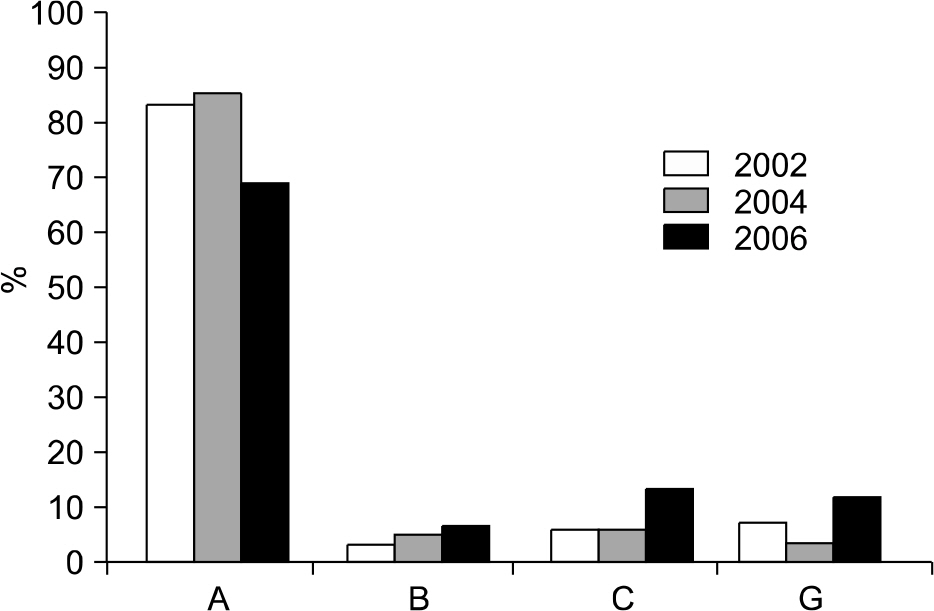Korean J Clin Microbiol.
2008 Apr;11(1):1-4. 10.5145/KJCM.2008.11.1.1.
Microbiological Characteristics of Throat Cultures from School Children in Jinju, 2006
- Affiliations
-
- 1Department of Laboratory Medicine, Institute of Health Sciences, Gyeongsang National University School of Medicine, Jinju, Korea. sjkim8239@hanmail.net
- KMID: 2089800
- DOI: http://doi.org/10.5145/KJCM.2008.11.1.1
Abstract
-
BACKGROUND: Group A streptococci (GAS) are the most common cause of pharyngitis in children. The streptococci in throat cultures from healthy elementary school children in Jinju were compared with previous results.
METHODS
Throat cultures were taken from 1,402 healthy school children in 2006. beta-hemolytic streptococci (BHS) were identified with a bacitracin disk (0.04 U) and latex agglutination test (Seroiden Strepto Kit, Eiken, Tokyo, Japan).
RESULTS
Two-hundred sixteen (15.4%) and 149 (10.6%) cultures grew BHS and GAS, respectively. The isolation rate of GAS was significantly lower than in 2004 (16.0%) or 2002 (16.9%) (P<0.05). Among BHS, the prevalence of group A strains (69.0%) decreased significantly compared with 2004 (84.9%) and 2002 (83.8%) (P<0.05). None of the 1st-grade children yielded BHS or GAS.
CONCLUSION
The isolation rates of BHS and GAS from healthy school children were lower in 2006 than in previous years. Natural immunization against the common serotypes or improvement in individual hygiene might have played roles in the reduction of isolations of GAS.
MeSH Terms
Figure
Reference
-
References
1. Bisno AL, Gerber MA, Gwaltney JM Jr, Kaplan EL, Schwartz RH. Infectious Diseases Society of America. Practice guidelines for the diagnosis and management of group A streptococcal pharyngitis. Infectious Diseases Society of America. Clin Infect Dis. 2002; 35:113–25.2. Bingol-Kologlu M, Yildiz RV, Alper B, Yagmurlu A, Ciftci E, Gokcora IH, et al. Necrotizing fasciitis in children: diagnostic and therapeutic aspects. J Pediatr Surg. 2007; 42:1892–7.3. Kim SJ. Epidemiological surveillance of group A streptococci isolated from school children using emm genotyping. Korean J Lab Med. 2002; 22:417–23.4. Koh EH and Kim S. Distribution of beta-hemolytic streptoccci of throat culture of elementary school children in Jinju area, 2004. Korean J Clin Microbiol. 2005; 8:51–6.5. Lindbaek M, Hoiby EA, Lermark G, Steinsholt IM, Hjortdahl P. Clinical symptoms and signs in sore throat patients with large colony variant beta-haemolytic streptococci groups C or G versus group A. Br J Gen Pract. 2005; 55:615–9.6. Kim S and Lee NY. Epidemiological usefulness of anti-opacity factor antibody screening in schoolchildren. J Clin Microbiol. 2001; 39:1316–8.
Article7. Prakash K and Lakshmy A. Streptococcal throat carriage in school children with special reference to seasonal incidence. Southeast Asian J Trop Med Public Health. 1992; 23:705–10.8. Lee KY. Seasonal incidence of streptococcal carriers in school children in Korea and its correlationship with streptococcal diseases. Yonsei J Med Sci. 1974; 7:126–38.9. Wannamaker LW. Perplexity and precision in the diagnosis of streptococcal pharyngitis. Am J Dis Child. 1972; 124:352–8.
Article10. Kim SJ. Evaluation of streptococcus selective agar (ssA) for recovery of group A streptococci from throat cultures. J Lab Med Qual Assur. 1997; 19:185–90.11. Kim SJ. Bacteriologic characteristics and serotypings of Streptococcus pyogenes isolated from throats of school children. Yonsei Med J. 2000; 41:56–60.
- Full Text Links
- Actions
-
Cited
- CITED
-
- Close
- Share
- Similar articles
-
- Distribution of Beta-Hemolytic Streptococci of Throat Culture of Elementary School Children in Jinju Area, 2004
- Serial Evaluation of Serotypes of Group A Streptococci Isolated from Throat Culture of Normal School Children
- Optimal site of throat swab for the isolation of beta-hemolytic streptococci
- Bacteriologic characteristics and serotypings of Streptococcus pyogenes isolated from throats of school children
- Epidemiological Characterization of Group A Streptococci Using emm Genotyping from Throat Cultures in Patients with Acute Pharyngitis in Children



